By Graham Gauld
All around the South of France there are former racing drivers tucked away in villages, or otherwise holed up in Monaco trying to preserve their race winnings. As a result one (this author, at any rate) tends to meet up with them from time to time and chew the fat. One of them who has become a good friend is Bernard Consten, best known for his multiple wins on the old original Tour De France event with his Jaguar 3.8 and Alfa Romeo. Bernard managed to combine rally driving with racing.
Consten has all the charm of a Parisian whose father ran a successful Renault dealership that allowed Bernard to follow his passion for motor sport.
He was born in the Courbevois district of Paris in 1932 and almost as soon as he had his driving license he began competing. His first event was the circuit de Bressuire with a little Renault 750 sedan. When competing on rallies he normally took his cousin, Jean Hebert, who was himself to become a successful driver with Alfa Romeo. The Consten/Hebert duo soon began to win a number of events which eventually led to Consten becoming French Rally Champion for the first time in 1958. He also became Champion in 1961 and 1962, on both occasions with a Jaguar 3.8 sedan, and finally in 1967 with an Alfa Romeo GTA.
The Tour de France wins are the ones that remain in the memory.
” In 1951 the Tour de France restarted and when I was a student I dreamed about competing on that event. The following year my mother was keen to buy me a Triumph TR2.
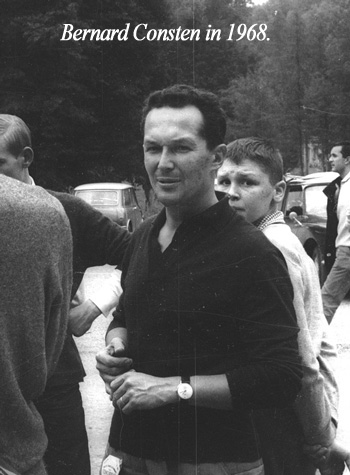
“It was very difficult to buy new cars in France at that time as it was not long after the war. You had to have the right currency as the French importer was only allowed to import about five or six cars a year. When I went to order the car the dealer asked me all the things I wanted. I told him it was to be white with red upholstery with wire wheels – even the heater was an extra. He then asked me how I was going to pay: American dollars, German marks or English pounds. When I told him I wanted to pay in French francs he said it was not possible to have a car.
“Luckily my friend, Andre Costa, the Managing Director of L’Auto Journal, had just done a road test of the TR2. He called the importer and suggested he sold the car to me and that is how I came to have my first Triumph. I entered it for the 1954 Tour de France and finished eleventh. In 1955 the event was cancelled due to the Le Mans disaster and in 1956 I competed in the Tour De France under the pseudonym “Bessey” ( B. C. Bernard Consten) to avoid any problems with the Army administration as I was doing my army service at the time. The car was a Porsche Carrera and I finished 9th overall.
“For 1957 they changed the regulations for the Tour to make it two classes, Touring Cars and GT cars so for this event I bought a Jaguar 3.4 from Charlie Delacroix who was the French importer.
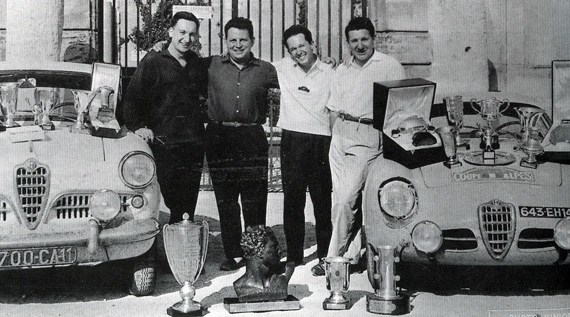
1958 Alpine Cup winners Roger de Lageneste, right, and Bernard Consten , second from right. display their silverware. Credit Consten collection.
“I took the car to Mont Revard to test it and coming downhill I ran out of brakes. When I got back to Paris Charlie Delacroix rang Coventry and asked if we could fit the disc brakes from an XK150 to the 3.4 and they told us there was no way this could be done. This meant I had to do the Tour de France with drum brakes. On the first day we were in the lead in the Touring class battling against Nano da Silva Ramos in another Jaguar. On the third day we were delayed in Rennes repairing the brakes and then, when catching up time, we had an accident with a Citroen. Of the three Jaguars on the Tour that year da Silva Ramos retired with the fuel pump, Peter Jopp crashed at Le Mans and his car burned out and I had my accident”.
One week after that Tour Consten went to the Paris Motor Show where the big news was that the Jaguar 3.4 was now available with disc brakes! He was not impressed.
“When I completed my National Service I bought a Giulietta Sprint Veloce. The choice was either a Sprint Veloce or a Porsche Carrera 1600. The Porsche dealer offered me a small discount but he had Claude Storez driving for him. I then went to the Alfa dealership and they offered me not only a larger discount, but if I had some good results they would give me assistance. As with Delacroix and the Jaguars, I always bought my own cars but I had the support of the dealerships in the preparation.
“In 1958 my cousin (Jean Hebert) and I had three cars between us, a Group N Giulietta, a Group 2 Giulietta and a Sprint Veloce Zagato, all prepared by Conrero to run in GT. As most of the rallies had some kind of Index of Performance we used whichever car suited the regulations best.”
In an example of poetic justice Consten and Hebert ran their Giulietta in the 1958 Tour de France and won the Touring Category, beating the Jaguars of Tommy Sopwith and Peter Whitehead!
By the time the Jaguar 3.8 came along in 1958, it was obviously the car to have and Consten bought one for the 1960 season. He won the Touring Car Class on the Tour de France for the second time. He was to go on and win the Touring Car class in 1962 and 1963 also in Jaguar 3.8s and thus he is the only driver in the history of the Tour de France to have won his category four times.
This was always Bernard Consten’s aim and at the time he tended to choose rally events where there were similar circuit tests to the Tour de France. At the same time he was competing in a number of circuit races. It must also be remembered that, despite his successes on the Tour de France, he was never given a factory Jaguar to drive. His wins came either with his own private car or with his friend Delacroix’s dealership car.
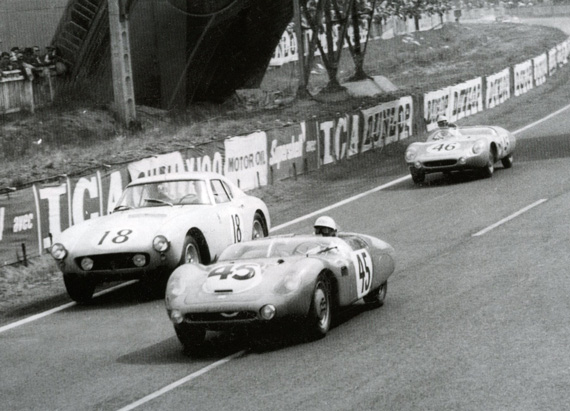
Consten/Armagnac at Le Mans in 1959 with the D.B. number 45. They placed 11th overall and won the Index of Thermal Efficiency. Number 46 D.B. won the Index of Peformance.
In 1958 he was approached to co-drive one of the factory Panhard-Monopoles powered by the raucous twin cylinder 750cc Panhard engine at Le Mans. Though he and Jean Vinatier managed to complete ten hours of racing, the engine expired once more. Commenting on his entire Le Mans career Consten remarks:
“…I was quite surprised at the poor quality of the preparation of the cars I raced. I always drove for factory teams and had many problems but I competed in over 200 rallies and retired maybe only five or six times. At Le Mans I competed six times and retired on four of them; on two of these I never even took the wheel. A good example was in 1961 when I shared one of John Ogier’s Aston Martin DB4 Zagato’s with the English driver Jack Fairman. We had two cars (the other driven by Australians Lex Davison and Bib Stilwell) and both cars were out within three hours.”
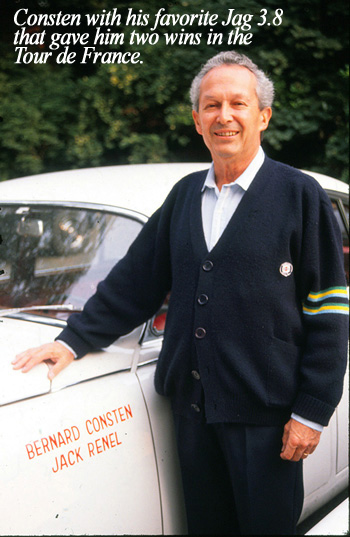 In 1959, however, came one of those incidents that happen from time to time with the Le Mans organizers. Despite being French Rally Champion and second in the European Championship, Bernard Consten was refused an entry for Le Mans in his Ferrari 250GT; which he was to share with journalist Jose Rosinski. As he had already raced twice at Le Mans, it appeared a bit of a slap in the face. However, Automobiles Deutsch et Bonnet (DB) approached him to drive a factory DB the same year with the experienced Paul Armagnac. This the Le Mans organisers accepted. Consten and Armagnac not only finished a credible 11th overall but won the prestigious Index of Thermal Efficiency. Consten could be forgiven for afterwards thumbing his nose at the organizers as this was a tremendous achievement; what is more they averaged nearly 88 mph for the entire 24 hours.
In 1959, however, came one of those incidents that happen from time to time with the Le Mans organizers. Despite being French Rally Champion and second in the European Championship, Bernard Consten was refused an entry for Le Mans in his Ferrari 250GT; which he was to share with journalist Jose Rosinski. As he had already raced twice at Le Mans, it appeared a bit of a slap in the face. However, Automobiles Deutsch et Bonnet (DB) approached him to drive a factory DB the same year with the experienced Paul Armagnac. This the Le Mans organisers accepted. Consten and Armagnac not only finished a credible 11th overall but won the prestigious Index of Thermal Efficiency. Consten could be forgiven for afterwards thumbing his nose at the organizers as this was a tremendous achievement; what is more they averaged nearly 88 mph for the entire 24 hours.
In 1963, his friend Delacroix came back and asked him if he would like to drive a Lotus Elan on the Tour de Corse rally – Delacroix was by this time the Lotus distributor. Consten took a friend, Claude Le Guezec with him.
” I had been warned by Gerard Crombac of Sport Auto that the Elan was not very reliable but the handling on the Corsican roads was fantastic and after the first two kilometers I felt sure we would win the GT class. I think it was the only time the Tour de Corse was run in dry weather from start to finish. Jo Schlesser beat us in a 7 litre AC Shelby Cobra. Mind you I think he changed tires about ten times.”
When Shell pulled out of the sponsorship of the Tour de France in 1964, the event stopped. However, in 1968 Bernard Consten became president of the French motor sport association. As a result he restarted the Tour de France in 1969 and ran it until the 1980’s. His successor as President of the French motor sport association was the legendary Jean Marie Balestre.
Bernard kept quite a few interesting cars including one of the Interim Berlinetta 250GT Ferraris but he has sold off many of them and lives quietly in Grasse, the town famous for perfume, in the South of France. We meet up regularly, particularly at the Concours d’Elegance near St Raphael where I am normally a judge and Bernard turns up with his immaculate Mercedes-Benz 300SL. He always has a smile on his face and is still one of France’s most successful competitors.
This article was originally published in June of 2012 by VeloceToday.com.
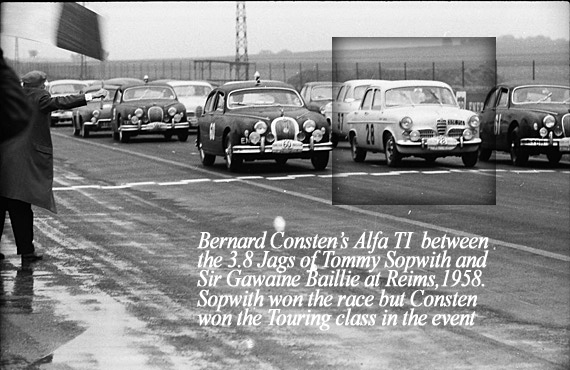
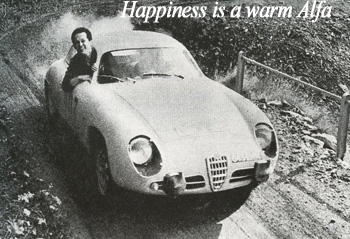
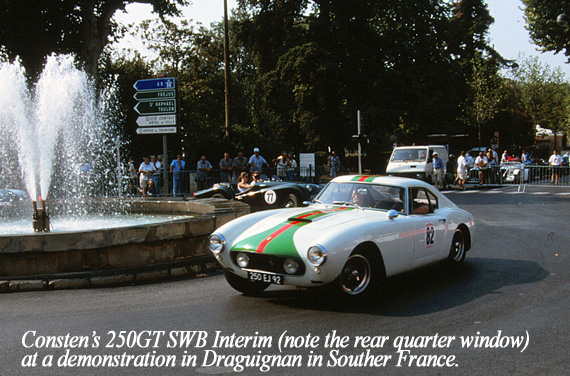
what would it take to bring this level of true sport back again?
Wonderful, well written article. Bernard looks great next to his Jaguar in the photo. It must be the French diet. All the best Bernard and thanks to the author!!
Hello Graham Gauld
Came by an article you wrote on Bernard Consten. August 2015.
A well done history, around the Rally master back in the fifties.
As you both lives in the south of France.
Do you by any chance know, where the SVZ went. When he stopped racing it in 1959,
The last result I can find it the victory at Rally Alsace Lorraine in 1959.
After that there is some start/results together with Rosinski in SVZ chassis *02158.
I hope you will be able to help me.
Yours sincerely
Bjarke Aunsbjørn